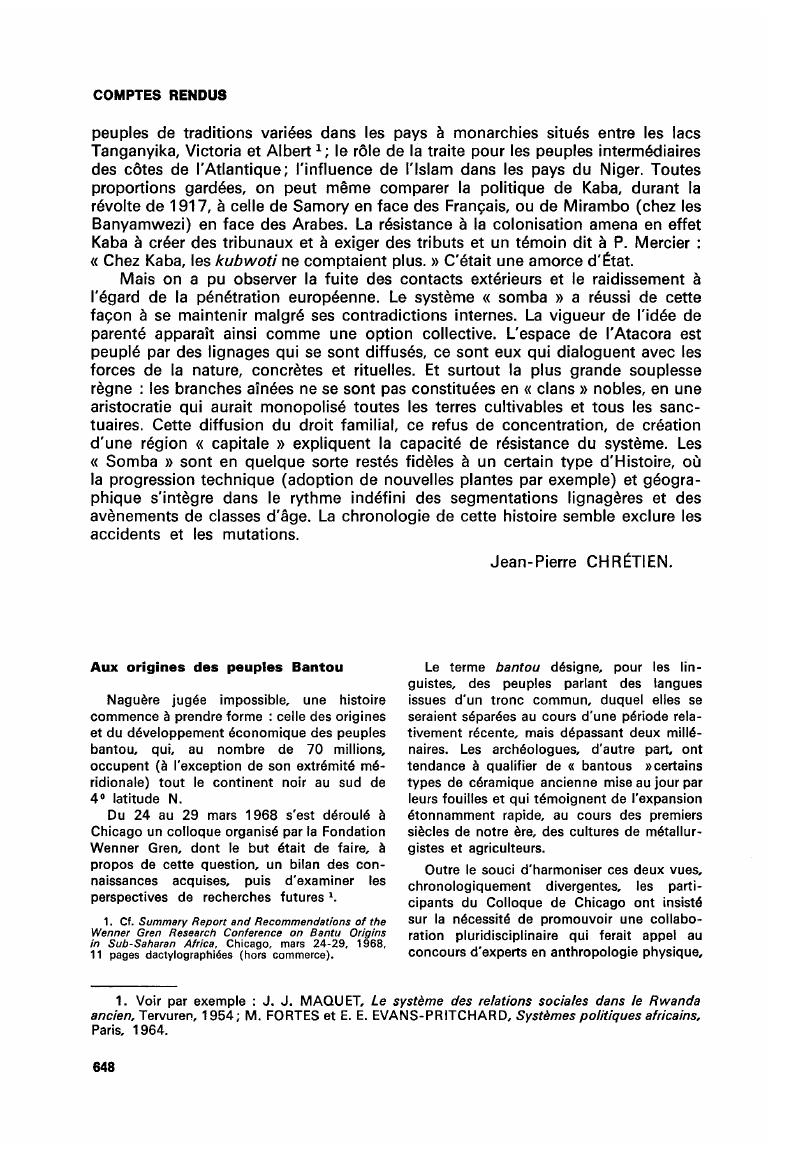No CrossRef data available.
Published online by Cambridge University Press: 11 October 2017

page 648 note 1. Cf. Summary Report and Recommandations of the Wenner Gren Research Conférence on Bantu Or/gins in Sub-Saharan Africa, Chicago, mars 24-29, 1968, 11 pages dactylographiées (hors commerce).
page 649 note 1. Cette hypothèse fut émise en 1960 par Wrigley, C. C., « Spéculations on the Economie Prehistory of Africa », in Journal of African History, vol. I, n° 2, (1960), p. 195.Google Scholar Auguste Chevalier proposait déjà en 1938 « le Sahara et les pays aujourd'hui désertiques situés à l'est du massif abyssin » comme centre d'origine des sorghos et des pénicillaires. Cf. Aug. CH Evalier « Le Sahara, Centre d'origine de plantes cultivées », in Société de Biogéographie VI : « La Vie dans la région désertique nord-tropicale de l'Ancien Monde », Paris, 1938, pp. 309-322.
page 649 note 2. Cf. J. D. Clark, « The Problem of Neolithic Culture in Sub-Saharan Africa », in Clark, J. D. et Bishop, W. W., Background to Evolution in Africa, Chicago, 1967, pp. 601–607 Google Scholar; et idem : « A Record of Early Agriculture and Metallurgy in Africa from Archaeological Sources », in Gabel, Creighton et Bennett, Norman R., Reconstructing African Culture History, Boston University Press, 1967, pp. 3–24.Google Scholar Voir aussi du même, « The Spread of Food Production in Sub-Saharan Africa », in Journal of African History, vol. III, n° 2, (1962), pp. 211-228, et « Africa South of the Sahara », in Braidwood, R. J. et Willey, G., Courses toward Urban Life, New York, 1962, pp. 1–33.Google Scholar
page 649 note 1. C. C. Wrigley estime que les plantes asiatiques n'ont pas joué le rôle révolutionnaire que leur attribue Murdock, (Africa : Its Peoples and their Culture History, New York, 1959).Google Scholar Son avis fut repris par le colloque de Chicago (cf. Wrigley, C. C., « Spéculations on the Economie Prehistory of Africa », in Journal of African History, vol. I, n° 2 (1960), p. 201.Google Scholar
page 649 note 2. Parmi les études les plus récentes sur le problème cf. Guthrie, Malcolm, « Bantu Origins : a tentative new hypothesis », in Journal of African Languages, vol. I, pt. I, (1962), pp. 9–21 Google Scholar ; idem, « Some developments in the prehistory of the Bantu languages », in Journal of African History, vol. III, n° 2, (1962), pp. 9-21 ; Oliver, R., « The Problem of Bantu Expansion », in Journal of African History, vol. VII, n° 3, (1966), pp. 361–376 CrossRefGoogle Scholar; Posnansky, M., « Bantu Genesis. Archaeological Reflexions », in Journal of African History, vol. IX, n° 1, (1968), pp. 1–11 CrossRefGoogle Scholar ; Hiernaux, J., « Bantu Expansion : The Evidence from Physical Anthropology confronted with linguistic and archaeological évidence », in Journal of African History, vol. IX, n° 4, (1968), pp. 505–515.CrossRefGoogle Scholar
page 649 note 3. Cf. La démarche très suggestive de Braidwood, R. J. et Reed, C. A.. « The Achievement and Early Conséquences of Food Production. A Considération o’ the Archaeological and Natural-Historical Evidence », in Cold Spring Harbour Symposia in Quantitative Biology, vol. XXII, (1957), pp. 17–31.Google Scholar Voir Howells, W. W., « Estimating Population Numbers through archaeological and skeletal remains », in Heizer, R. F. (ed) ; The Application of Quantitative Methods in Archaeology, Chicago, 1960.Google Scholar
page 650 note 1. Fortes, M. et Evans-pritchard, E. E., African Political Systems, Londres, 1940.Google Scholar Introduction VI : « Il existe certainement un rapport entre le degré de développement politique d'une peuplade donnée et le nombre de ses habitants; mais il serait certainement inexact de supposer que les sociétés à plus grande densité de population possèdent, de ce fait, des institutions gouvernementales. Le contraire est tout aussi probable, à en juger par notre matériel d'information. »
page 650 note 2. Stevenson, Robert F., Population and Political Systems in Tropical Africa, Columbia University Press, 1968, 304 p.Google Scholar
page 650 note 1. Oliver, R. et Fage, J. D., A Short History of Africa, Londres, 1962, Éditions Penguin, p. 46.Google Scholar
page 650 note 2. Ibid., p. 51.
page 650 note 3. Baumann ( Baumann, H. et Westermann, D., Les Peuples et les Civilisations de l'Afrique, Paris, 1957 pp. 50 Google Scholar et 52) avait en effet trouvé dans la « civilisation des Chamites, éleveurs de gros bétail » un lien entre le chef et le bétail, mais il n'avait nullement tenu les Chamites éleveurs comme ayant introduit des institutions étatiques, car il spécifiait bien que « la case sacrée avec ses ustensils sacrés, le chef faiseur de pluie et la mort imposée au chef, sont des notions certainement nonchamitiques… ».
page 650 note 4. Cf. Wrigley, C. C., « Spéculations on the Economie Prehistory of Africa », in Journal of African History, vol. 1, n° 2, (1960), pp. 200–203 CrossRefGoogle Scholar; Lewis, Herbert S., « Ethnology and Culture History », in Gabel, Creighton et Bennett, Norman R., Reconstructing African Culture History, Boston Univ. Press, 1967, p. 36 Google Scholar, et Posnansky, M., « Bantu Gensis — Archaeological Reflexions », in Journal of African History, vol. IX, n° 1, (1968), p. 10.Google Scholar